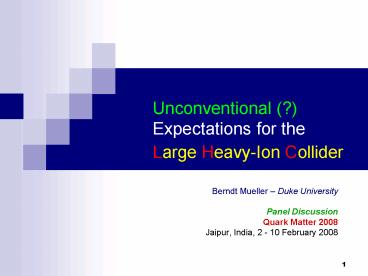Unconventional (?) Expectations for the Large Heavy-Ion Collider - PowerPoint PPT Presentation
Title:
Unconventional (?) Expectations for the Large Heavy-Ion Collider
Description:
1. Unconventional (?) Expectations for the. Large Heavy-Ion Collider ... heavy-ion collisions. Targeted at graduate students & junior postdocs ... – PowerPoint PPT presentation
Number of Views:19
Avg rating:3.0/5.0
Title: Unconventional (?) Expectations for the Large Heavy-Ion Collider
1
Unconventional (?)Expectations for theLarge
Heavy-Ion Collider
- Berndt Mueller Duke University
- Panel Discussion
- Quark Matter 2008
- Jaipur, India, 2 - 10 February 2008
2
Two extreme scenarios
- The SPS discovered the CQGP
- RHIC discovered the BQGP (aka the perfect
liquid) - Will the LHC discover the AQGP ?
V. Koch
- QGP physics at the LHC will be just like RHIC,
only at higher (initial) energy
density/temperature and with probes that have a
(much) larger kinematic range. - QGP physics at the LHC will be quite different
from that seen at RHIC, involving an (initially)
weakly coupled deconfined phase and an initial
state dominated by gluon saturation.
3
Predicting the future is hard
but we can learn from the past!
4
A challenge for us all
Is QGP physics at RHIC and the SPS the same or
different ?
5
Dynamic range SPS/RHIC/LHC - (x,t)
Hydro works at RHIC, but does not work at the
SPS. - But
6
Dynamic range SPS/RHIC/LHC - (pT)
Jet physics
Statistical hadronization
Recombi-nation
SPS
?
How far in pT does the reco domain extend at LHC?
Will we see jet-jet recombination?
Particle ID up to 30 GeV (?) will be
critical to detailed study of hadronization
dynamics.
7
A challenge for theorists
What can we learn about the QGP from N 4 SYM ?
- What are the limits of a toy model of QCD without
an intrinsic scale ? - Does the absence of a hadronic phase limit in N
4 SYM the usefulness of the AdS/CFT duality for
HI physics ? - Can this limitation be overcome by introducing a
confinement scale into the toy model ? Is there
an effective AdS/CFT type theory that works both,
at low energy and in the domain relevant for hard
probes?
8
Mach cone in QCD vs. N4 SYM
u 0.99955 c
R.B. Neufeld (preliminary)
Chesler Yaffe arXiv0712.0050
u 0.75 c
9
Virtual Journal on QCD Matter
- Digest of preprints on
- hot dense QCD matter
- the QGP
- relat. heavy-ion collisions
- Targeted at graduate students junior postdocs
- Aims to provide a bigger picture, on how
individual publications shape the advancement of
the field
http//qgp.phy.duke.edu/































